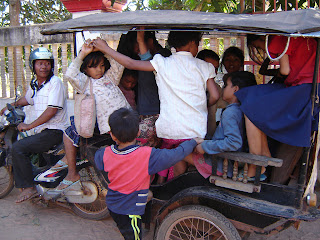Anyhoo, we spent the week revising various bits and pieces: doing word and vocab games on Monday; learning the names of buildings in cities on Tuesday – not sure these kids really understand what an aquarium is or will ever visit one and, if they do, they’ll probably wonder why they can’t eat the fish; using those building names with prepositions in sentences on Wednesday – ‘The aquarium is opposite the fish market’; and drawing a map of an imaginary city, adding its buildings and talking about their cities on  Thursday. There was no school Friday as 7 January is a public holiday, variously called Victory over Genocide Day, or Liberation Day, commemorating the day P
Thursday. There was no school Friday as 7 January is a public holiday, variously called Victory over Genocide Day, or Liberation Day, commemorating the day Phnom Penh
 Thursday. There was no school Friday as 7 January is a public holiday, variously called Victory over Genocide Day, or Liberation Day, commemorating the day P
Thursday. There was no school Friday as 7 January is a public holiday, variously called Victory over Genocide Day, or Liberation Day, commemorating the day PIn General Studies the topic was food hygiene, a relevant enough issue but it’s not easy to find teaching worksheets that don’t include ‘what temperatures your fridge and freezer should be set at’ or ‘defrost food products on the lowest shelf in your refrigerator’! As some of the Anjali kids don’t even have electricity in their homes, anything that involved refrigeration was out of the question.
 |
| One of the women who cooks lunch every day for kids, staff and volunteers at Anjali |
I eventually settled on four basic points to hammer home to them during the week:
* always wash your hands before touching food
* always wash fruit and vegetables before you eat them
* scrub the cutting board before and after you use it
* make sure meat and chicken is cooked thoroughly before you eat it
On Monday we went through a reading on the topic – they laughed hysterically when I mimed the meaning of diarrhoea, something they could all relate to! On Tuesday, we did a quiz to see how much they remembered from Monday, then did some revision when it was obvious they had forgotten almost everything but the diarrhoea! And on Wednesday, they produced some colourful posters (no, they didn’t draw the diarrhoea!), which now have pride of place on the wall outside their classroom. (Sorry, I forgot to take photos of these.) On Thursday, I reverted to supporting the English lessons with a city buildings word search and ‘find the differences between two city images’ activity as I couldn’t find a way to work the food hygiene idea any further.
Our workshop activities this week included making Anjali signs to support their football team’s first game in this year’s competition, the first round of which was the following Sunday; origami – I had taken some multi-coloured and patterned origami paper with me and the school has several instruction books, so we produced all sorts of weird and wonderful creatures and shapes; jewellery making – I had also taken over a supply of plastic and glass beads, shirring elastic and plastic string, so the kids produced a variety of colourful bracelets and necklaces; and games. One of this week’s new volunteers, Courtenay from Tasmania
The great success of the week was how well the garden was growing, and the fact that the kids were watering it every morning without being asked. Here are some photos taken the following week, on my last day at Anjali. The plant growth in just over three weeks is phenomenal!
One of the highlights of the week for me was actually not at Anjali. On Tuesday afternoon I joined Marianne and her Advanced class on a visit to Grace House Community Centre. Established by Globalteer just two years ago, it is a glowing testament to the dedication, hard work and enthusiasm of its manager Bridget Cordory and her husband Alan. It was incredible to see the advances and improvements they had instigated at Grace House in the year since I last visited. They have built additional classrooms, a toilet block, a volleyball court and football field, developed gardens for the local villagers to grow their own food, as well as building a vocational block, where they are already training older boys to be electricians and are about to start teaching woodworking and woodturning skills. Alan proudly gave us a guided tour of these workshops, showing us samples of the beautiful wooden products they plan to make and sell.
Grace House is a model school and community centre, supporting the poverty-stricken people of Kor Kranh village which surrounds the school site and two other villages located between Siem Reap and Tonle Sap lake. They have now achieved NGO status and operate independently of Globalteer, though still receive support when desperate and for special projects. Bridget told us stories of sleepless nights when she worried about how to pay for the following month’s rice supplies to desperate villagers, so if you have a few spare dollars, I can definitely recommend you donate to this extremely worthy cause. Here’s the link: http://www.gracehousecambodia.org/how_to_help.html





No comments:
Post a Comment